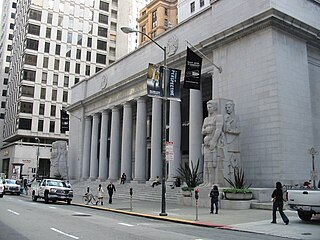
The Pacific Exchange was a regional stock exchange in California, from 1956 to 2006. Its main exchange floor and building were in San Francisco, California, with a branch building in Los Angeles, California.

Downtown Long Beach is the heart of Long Beach, California, United States. It is the location for most of the city's major tourist attractions and municipal services, and for numerous businesses. There are many hotels and restaurants in the area that serve locals, tourists, and convention visitors.
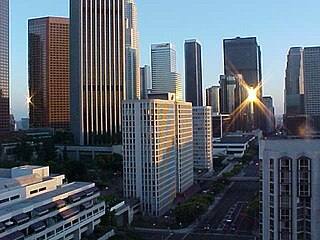
The Financial District is the central business district of Los Angeles along Olive, Grand, Hope, Flower and Figueroa streets from 4th Street to 8th Street. It is south of the Bunker Hill district, west of the Historic Core, north of South Park and east of the Harbor Freeway and Central City West. Like Bunker Hill, the Financial District is home to corporate office skyscrapers, hotels and related services as well as banks, law firms, and real estate companies. However, unlike Bunker Hill which was razed and now consists of buildings constructed since the 1960s, it contains large buildings from the early 20th century, particularly along Seventh Street, once the city's upscale shopping street; the area also attracts visitors as the 7th and Flower area is at the center of the regional Metro rail system and is replete with restaurants, bars, and shopping at two urban malls.

The Eastern Columbia Building, also known as the Eastern Columbia Lofts, is a thirteen-story Art Deco building designed by Claud Beelman located at 849 S. Broadway in the Broadway Theater District of Downtown Los Angeles. It opened on September 12, 1930, after just nine months of construction. It was built at a cost of $1.25 million as the new headquarters and 39th store for the Eastern-Columbia Department Store, whose component Eastern and Columbia stores were founded by Adolph Sieroty and family. At the time of construction, the City of Los Angeles enforced a height limit of 150 feet (46 m), however the decorative clock tower was granted an exemption, allowing the clock a total height of 264 feet (80 m). J. V. McNeil Company was the general contractor.
Claud W. Beelman, sometimes known as Claude Beelman, was an American architect who designed many examples of Beaux-Arts, Art Deco, and Streamline Moderne style buildings. Many of his buildings are listed on the National Register of Historic Places.

The Garfield Building is a thirteen-story Art Deco style historic structure in Los Angeles, California. Designed by American architect Claud Beelman, construction lasted from 1928 to 1930. It is listed on the National Register of Historic Places.

El Cortez is a condominium building in San Diego, California. Built from 1926 to 1927, the El Cortez was the tallest building in San Diego when it opened. It sits atop a hill at the north end of Downtown San Diego, where it dominated the city skyline for many years and became a landmark hotel.
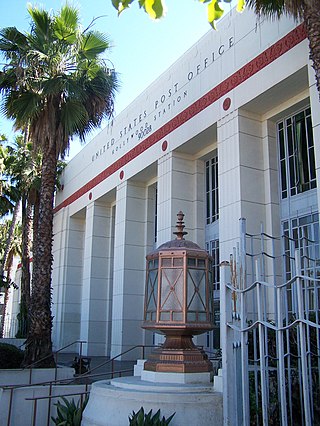
The United States Post Office in Hollywood, Los Angeles, California, also known as Hollywood Station, is an active U.S. post office located at 1615 Wilcox, between Sunset and Hollywood Boulevards. It is on the National Register of Historic Places.

The San Fernando Building is an Italian Renaissance Revival style building built in 1906 on Main Street in the Historic Core district of downtown Los Angeles, California. It was listed in the National Register of Historic Places in 1986, converted into lofts in 2000, and declared a Historic-Cultural Monument in 2002.

South Park Lofts, located in downtown Los Angeles, was built in 1924 as an eight-story parking garage. It was one of America's first parking structures, and is one of the few parking garages listed in the National Register of Historic Places, having received the distinction in 2004. The building has been converted to lofts and is now known as "South Park Lofts." As "Building at 816 Grand Avenue", it is one of more than ten buildings designed by Claud Beelman listed on the National Register.
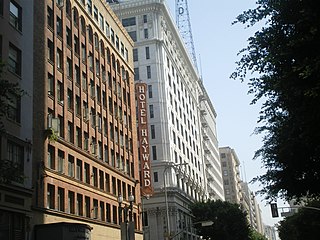
Spring Street in Los Angeles is one of the oldest streets in the city. Along Spring Street in Downtown Los Angeles, from just north of Fourth Street to just south of Seventh Street is the NRHP-listed Spring Street Financial District, nicknamed Wall Street of the West, lined with Beaux Arts buildings and currently experiencing gentrification. This section forms part of the Historic Core district of Downtown, together with portions of Hill, Broadway, Main and Los Angeles streets.

The Delphi Hotel is a 12-story hotel located at 550 S Flower St in Downtown Los Angeles in the marble-clad high-rise Superior Oil Company Building formerly the headquarters of the now defunct company, converted to The Standard Downtown LA hotel in 2002, then closed in 2020 and reopened in 2023 under its current name.

Cooper Arms Apartments is a registered historic building located on Ocean Boulevard in downtown Long Beach, California. The twelve-story Renaissance Revival apartment tower was built in 1923. It was one of the first structures to be designated a Long Beach Historical Landmark when the city launched its historic preservation program in 1980, and it was added to the National Register of Historic Places in 2000. It is currently operated as condominiums.
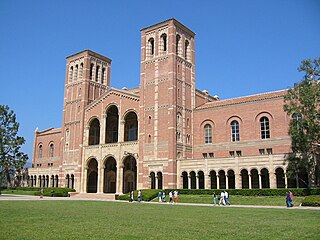
Allison & Allison was the architectural firm of James Edward Allison (1870-1955) and his brother David Clark Allison (1881-1962).

Walker & Eisen (1919−1941) was an architectural partnership of architects Albert R. Walker and Percy A. Eisen in Los Angeles, California.

William F. Curlett and Alexander Edward Curlett were a father-and-son pair of architects. They worked together as partners under the name of William Curlett and Son, Architects from c. 1908–1916. Aleck Curlett partnered with Claud Beelman as Curlett & Beelman (1919–1932).

The American Stock Exchange Building, formerly known as the New York Curb Exchange Building and also known as 86 Trinity Place or 123 Greenwich Street, is the former headquarters of the American Stock Exchange. Designed in two sections by Starrett & van Vleck, it is located between Greenwich Street and Trinity Place in the Financial District of Lower Manhattan in New York City, with its main entrance at Trinity Place. The building represents a link to the historical practices of stock trading outside the strictures of the New York Stock Exchange (NYSE), which took place outdoors "on the curb" prior to the construction of the structure.

The historic Los Angeles Stock Exchange Building, also called the Pacific Stock Exchange Building, is located in the Spring Street Financial District within the Historic Core in Los Angeles. It was the headquarters of the Los Angeles Stock Exchange and the Pacific Stock Exchange from 1931 to 1986. It was then the site of two nightclubs.

7th Street is a street in Los Angeles, California running from S. Norton Ave in Mid-Wilshire through Downtown Los Angeles. It goes all the way to the eastern city limits at Indiana Ave., and the border between Boyle Heights, Los Angeles and East Los Angeles.
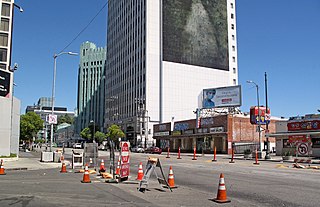
The Getty Building is a 22-storey former office tower in Los Angeles, California. The building was a project of J. Paul Getty and upon completion served as the head office of Getty Oil. The architect for the structure was Claud Beelman whose design was in a New Formalist mode. Construction began on March 14, 1961, and the building opened officially on April 22, 1963. After sitting vacant for a decade, the building underwent a residential conversion and reopened in 2007 as a condominium called the Mercury.























